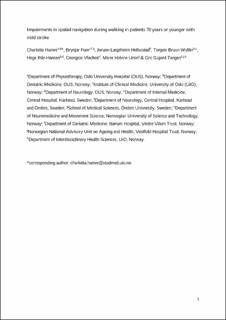| dc.description.abstract | Background: Spatial navigation, the ability to determine and maintain a route from one place to another, is needed for independence in everyday life. Knowledge about impairments in spatial navigation in people with mild stroke is scarce. Objectives: To explore impairments in spatial navigation in patients ≤70 years after first-ever mild ischemic stroke (NIHSS≤3) and to explore which variables are associated with these impairments 12 months later. Methods: Patients were examined in the acute phase, and after 3 and 12 months. To assess impairments in spatial navigation, we used the Floor Maze Test (FMT), with time and FMT-errors as outcomes. Patients’ perceived navigational skills were collected using self-report. Logistic regression was used to explore which variables (sociodemographic data, stroke characteristics, cognition, and mobility) were associated with impaired navigation ability. Results: Ninety-seven patients (20 females) were included. The mean (SD) age was 55.5 (11.4) years. Timed FMT improved significantly from the acute phase to 12 months (p = <.001). At 12 months, 24 (24.7%) of the participants walked through the maze with errors, and 22 (22.7%) reported spatial navigational problems. The Trail Making Test (TMT)-B was the only variable from the acute phase associated with FMT-errors at 12 months, and being female was the only variable associated with self-reported navigational problems at 12 months. Conclusion: Nearly one in four patients experienced spatial navigation problems 12 months after a mild stroke. Executive function (TMT-B), measured in the acute phase, was associated with navigational impairments (FMT-errors) at 12 months, and being female was associated with self-reported navigational problems | en_US |
